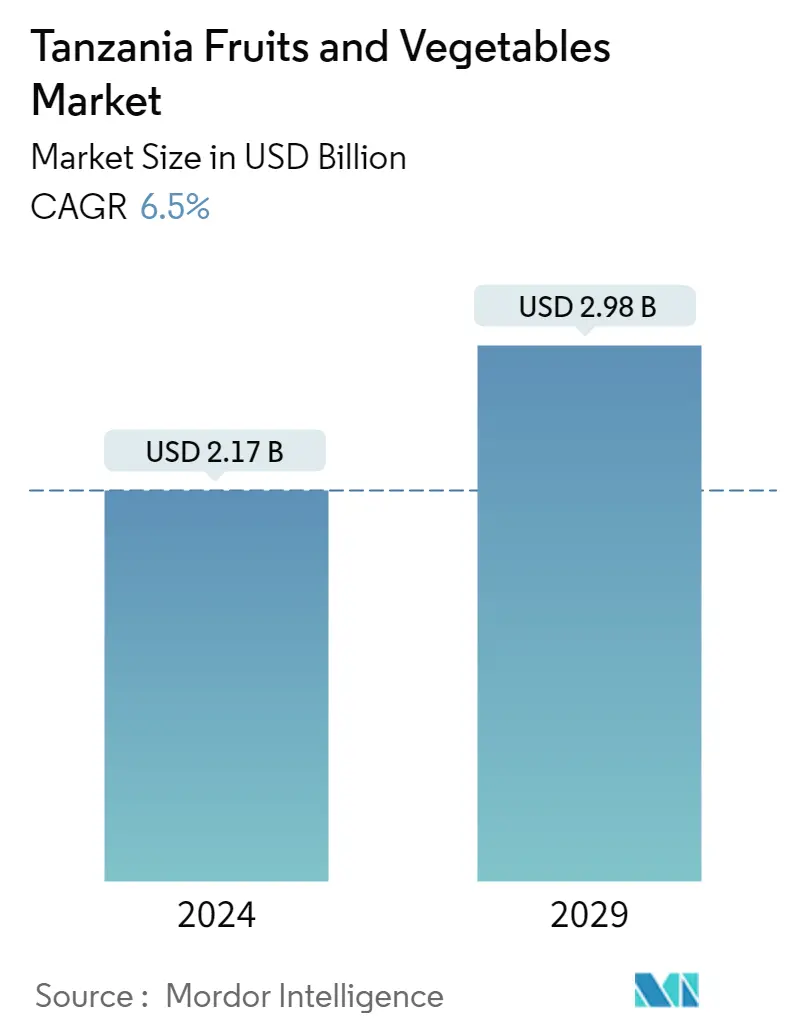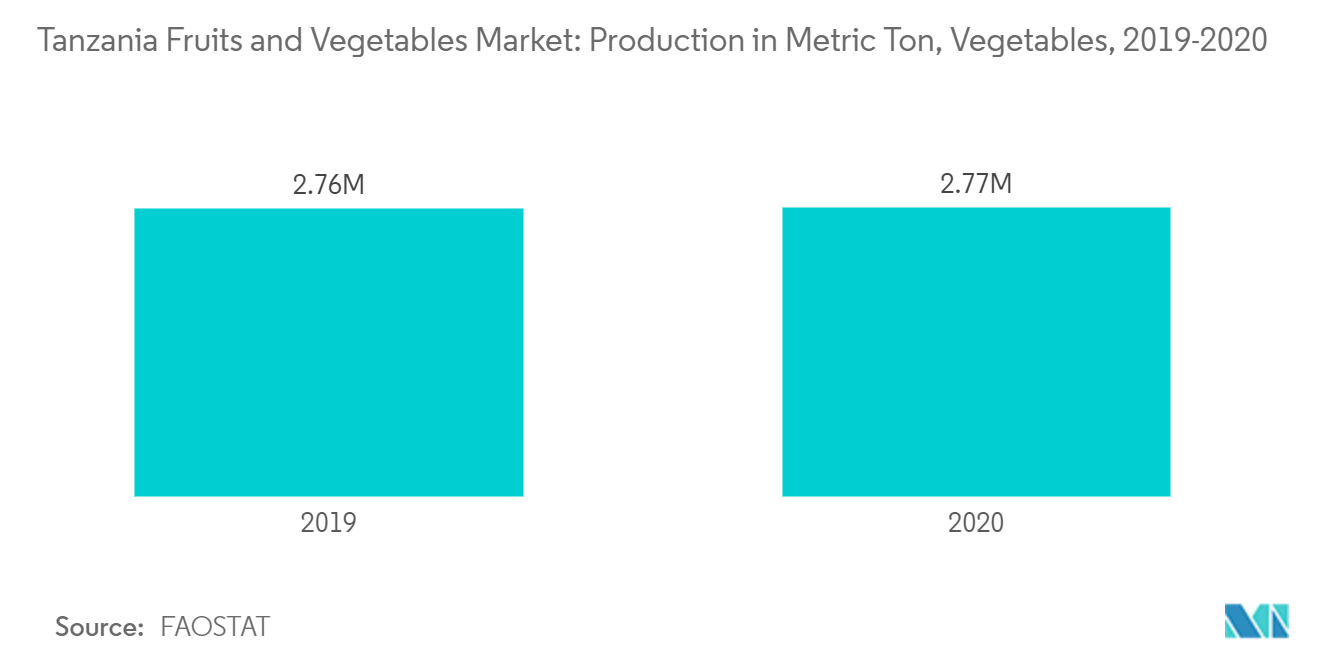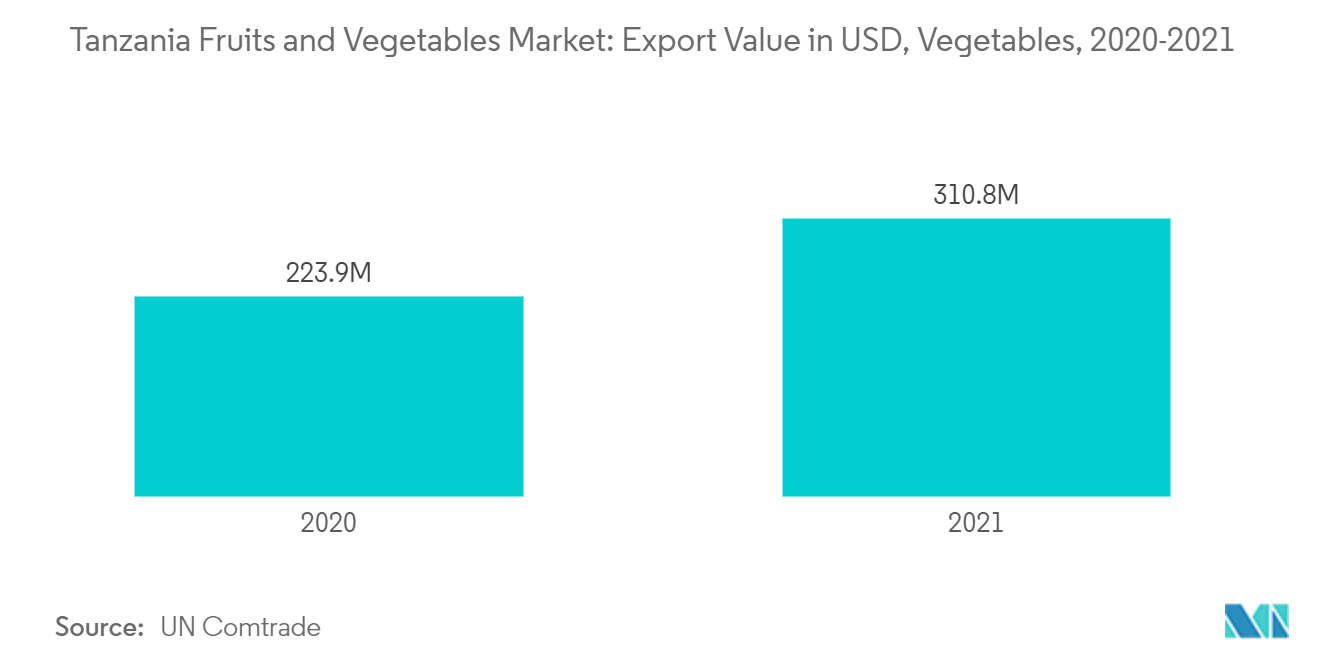Tanzania Fruits and Vegetables Market Size

| Study Period | 2019 - 2029 |
| Base Year For Estimation | 2023 |
| Forecast Data Period | 2024 - 2029 |
| Market Size (2024) | USD 2.17 Billion |
| Market Size (2029) | USD 2.98 Billion |
| CAGR (2024 - 2029) | 6.50 % |
Major Players*Disclaimer: Major Players sorted in no particular order |
Need a report that reflects how COVID-19 has impacted this market and its growth?
Tanzania Fruits and Vegetables Market Analysis
The Tanzania Fruits and Vegetables Market size is estimated at USD 2.17 billion in 2024, and is expected to reach USD 2.98 billion by 2029, growing at a CAGR of 6.5% during the forecast period (2024-2029).
- The growing demand for derived products, such as fruit juices and jams, and consumer awareness of healthier alternatives, such as fruits and vegetables, are some factors driving the market growth. Major fruits and vegetables produced in the country are bananas, mangoes, oranges, pineapples, watermelons, beans, cabbage, tomatoes, onions, chilies, and peppers. The country's banana market has massively developed due to exports and local consumer demand.
- According to Food and Agriculture Organization (FAO) stat data, vegetable production in Tanzania was 2.77 million metric tons in 2020, though the area harvest showed a slight drop in recent years. Fruit production in the country increased by almost 19% from 2017 and reached 5.6 million metric tons in 2020. The area harvested also showed an increase of nearly 3% from last year and got 795,477 hectares in 2020. The domestic demand for fruits has also seen an increasing trend.
- International buyers are increasingly looking out for Tanzanian-grown crops, especially avocados, raspberries, lime, and other high-value vegetables. This offers local farmers and exporters new markets and opportunities.
Tanzania Fruits and Vegetables Market Trends
This section covers the major market trends shaping the Tanzania Fruits & Vegetables Market according to our research experts:
Increase in Heath Consciousness among Consumers
- The growing health consciousness among Tanzanian consumers has resulted in consumers spending more on healthier foods such as fruits and vegetables. Health complications, such as weakening of the immune system and vitamin-C deficiency along with bleeding gums, have encouraged the country's people to include healthier alternatives like fruits and vegetables in their diets. This is reflected in an increase in the production of both fruits and vegetables in the country to accommodate the increasing demand.
- According to data from the Food and Agriculture Organization (FAO), the production of vegetables in 2017 was 2.76 million metric tons. Even though there was a drop in the areas used for vegetable harvest in recent years, the production in 2020 was 2.77 million metric tons. For fruits, the production increased from 4.7 million metric tons in 2017 to 5.6 million metric tons in 2020. This increasing consumer demand for fruits and vegetables can also be seen reflected in the imports. From ITC data, the import value of fresh vegetables rose by almost 16% from last year and reached 5.8 million USD in 2021.
- Furthermore, Tanzania has set nutrition targets to tackle malnutrition, undernutrition, overweight or obesity, and micronutrient deficiency, and it is striving to reduce stunting to 15% by 2025. This is anticipated to boost fruit and vegetable intake among Tanzanians. Also, organically produced crops are gaining traction due to the rise in consumer concerns over the usage of chemical pesticides or fertilizers. With the increase in consumers switching to healthier alternatives, the demand for fruits and vegetables is projected to grow during the forecast period.

Growing Export Opportunities
- Fruit and vegetable exports from Tanzania have grown in the past few years, becoming a leading sub-sector driving the agricultural sector's growth. The rising awareness targeting the export toward demanding markets helped the farmers increase the quality standards of their vegetables, making them highly profitable.
- Producers have formed groups to produce as contract farmers or out-growers to large-scale export firms, for instance, MUVIKHO, an umbrella organization comprising groups of vegetable farmers. Also, a national farmers' organization called TAHA (Tanzania Horticulture Association) represents all of the country's farmers regardless of their farm size. It has a direct link with the government and other stakeholders.
- Furthermore, the market is flourishing due to the increased consumer demand globally, and organizations are putting efforts into developing new varieties while producers focus on sustainable production. New markets like India are also opening up for fruits from Tanzania. For instance, In 2022, India opened its market for Tanzanian avocado, which is set to improve the export ties.
- According to ITC, major destination countries of fruit and vegetables from Tanzania are Vietnam, India, Netherlands, United Kingdom, among others. In 2021, the total export value for vegetables was USD 310.8 million, marking an increase of 40.6% from 2020. The major fruits produced and exported from the country are banana, mango, orange, watermelon, etc. Due to the trade liberalization policies, bananas are a highly traded commodity in the country. Bananas are famous primarily for their non-seasonal nature and play a key role in ensuring food availability all year round. The orange export from Tanzania is also increasing after a huge slump in the past years.
- According to ITC Trade data, in 2020, the export value was USD 151,000, and in 2021 it reached USD 481,000. Thus, the demand from export markets for sustainably produced fruits and vegetables is the main factor driving the market.

Tanzania Fruits and Vegetables Market News
- April 2022: The Tanzanian government with Tanzania Agriculture Research Institute (TARI), planned to produce 20 million improved avocado seedlings to be sold at a subsidized price.
- March 2022: The collaboration between World Vegetable Centre and Tanzania Agriculture Research Institute (TARI) to increase mungbean productivity has finally become fruitful and have launched a new mungbean verity.
- January 2022: A new market has opened up for the Tanzanian fruit sector. The Indian Ministry of Agriculture has granted Tanzania's avocado to enter the market.
Tanzania Fruits and Vegetables Market Report - Table of Contents
1. INTRODUCTION
- 1.1 Study Assumptions and Market Definition
- 1.2 Scope of the Study
2. RESEARCH METHODOLOGY
3. EXECUTIVE SUMMARY
4. MARKET DYNAMICS
- 4.1 Market Overview
- 4.2 Market Drivers
- 4.3 Market Restraints
5. MARKET SEGMENTATION
-
5.1 Vegetables
- 5.1.1 Production Analysis
- 5.1.2 Consumption Analysis (Volume and Value)
- 5.1.3 Import Market Analysis (Volume and Value)
- 5.1.4 Export Market Analysis (Volume and Value)
- 5.1.5 Price Trend Analysis
-
5.2 Fruits
- 5.2.1 Production Analysis
- 5.2.2 Consumption Analysis (Volume and Value)
- 5.2.3 Import Market Analysis (Volume and Value)
- 5.2.4 Export Market Analysis (Volume and Value)
- 5.2.5 Price Trend Analysis
6. INTERNATIONAL TRADE AND PRICE SCENARIOS
- 6.1 Bananas
- 6.2 Mangoes
- 6.3 Watermelons
- 6.4 Oranges
- 6.5 Pineapples
- 6.6 Beans
- 6.7 Cabbage
- 6.8 Tomatoes
- 6.9 Onions
- 6.10 Chilies and Peppers
7. REGIONAL ANALYSIS
- 7.1 PESTLE Analysis
- 7.2 Supply Chain Analysis
- 7.3 Government Policies
8. COMPETITIVE ANALYSIS
- 8.1 Distribution Network and Retail Analysis
- 8.2 Company Profiles
- *List Not Exhaustive
9. MARKET OPPORTUNITIES AND FUTURE TRENDS
** Subject To AvailablityTanzania Fruits and Vegetables Industry Segmentation
Vegetables are the edible portion of a plant, that are usually grouped according to the portion of the plant that is eaten such as leaves (lettuce), stem (celery), roots (carrot), tubers (potato), bulbs (onion) and flowers (broccoli). For the purpose of analysis, only fresh fruits and vegetables are considered. A fruit is a mature ovary of a seed plant, usually developed from a flower. The Tanzania fruits and vegetables market is segmented by fruits and vegetables. The offers production (volume), consumption (volume and value), import (volume and value), export (volume and value), and price trend analysis of fruits and vegetables in Tanzania. the report also offers an analysis of the international price trends of the most commonly traded fruits and vegetables in Tanzania (bananas, mangoes, oranges, pineapples, watermelons, beans, cabbage, tomatoes, onions, chilies, and peppers). The market estimation and forecasts are provided in terms of value (USD thousand) and volume (metric ton).
| Vegetables | Production Analysis |
| Consumption Analysis (Volume and Value) | |
| Import Market Analysis (Volume and Value) | |
| Export Market Analysis (Volume and Value) | |
| Price Trend Analysis | |
| Fruits | Production Analysis |
| Consumption Analysis (Volume and Value) | |
| Import Market Analysis (Volume and Value) | |
| Export Market Analysis (Volume and Value) | |
| Price Trend Analysis |
Tanzania Fruits and Vegetables Market Research FAQs
How big is the Tanzania Fruits and Vegetables Market?
The Tanzania Fruits and Vegetables Market size is expected to reach USD 2.17 billion in 2024 and grow at a CAGR of 6.5% to reach USD 2.98 billion by 2029.
What is the current Tanzania Fruits and Vegetables Market size?
In 2024, the Tanzania Fruits and Vegetables Market size is expected to reach USD 2.17 billion.
What years does this Tanzania Fruits and Vegetables Market cover, and what was the market size in 2023?
In 2023, the Tanzania Fruits and Vegetables Market size was estimated at USD 2.04 billion. The report covers the Tanzania Fruits and Vegetables Market historical market size for years: 2019, 2020, 2021, 2022 and 2023. The report also forecasts the Tanzania Fruits and Vegetables Market size for years: 2024, 2025, 2026, 2027, 2028 and 2029.
Fruits and Vegetables in Tanzania Industry Report
Statistics for the 2024 Fruits and Vegetables in Tanzania market share, size and revenue growth rate, created by Mordor Intelligence™ Industry Reports. Fruits and Vegetables in Tanzania analysis includes a market forecast outlook to 2029 and historical overview. Get a sample of this industry analysis as a free report PDF download.

